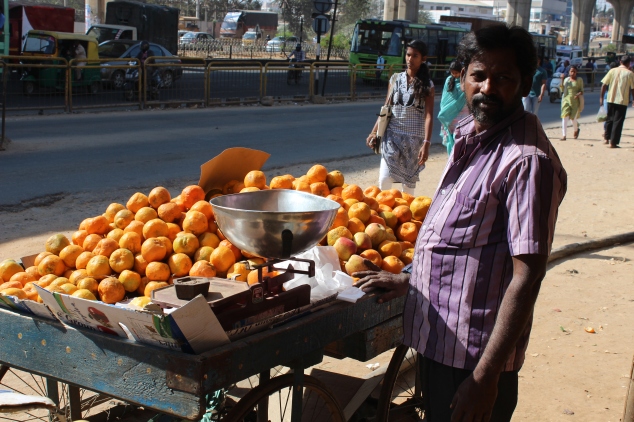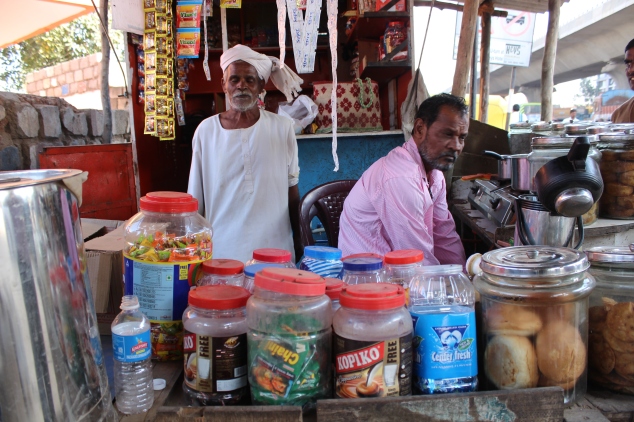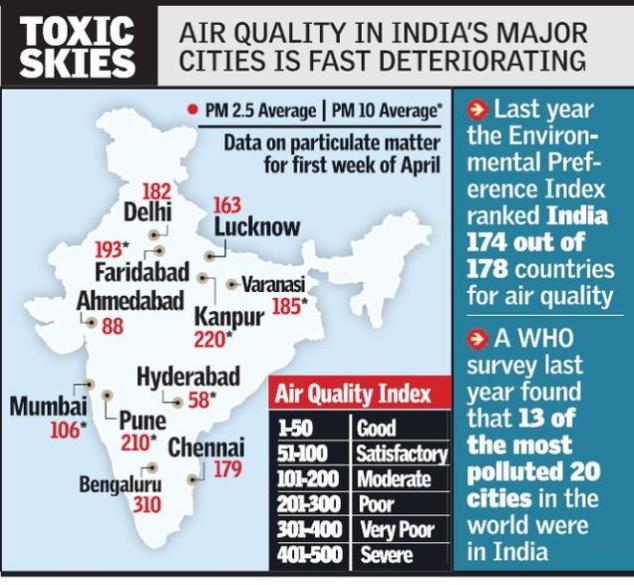Through the midst of this dusty junction, the blaring horns, people thronging to every side of the road and under the sweltering heat of the sun stands a man selling oranges, apples and pomegranates. He isn’t the only one there as he is accompanied by a fish seller to his left and another fruit seller to his right. On the opposite side of the road are vendors who sell sugarcane juice, flowers, pani puri and small meals.

This is Raja Anna who sells oranges at the corner of the junction. He has 6 daughters and every single one of them goes to school.
These are migrants who have come in from small districts of both Tamil Nadu and Karnataka, trying to make their ends meet through these small businesses. When they’re not worrying about making enough money to break even on a daily basis, they’re worried about the daily bribe they pay the police to have their stall there, apart from the official license which keeps them secure to begin with.

This is the tea stall where I shoot videos and click pictures from of what goes on at the Hosa Road Junction. They ensure that I have my chai and bun as regularly as I want them, throwing in special bites once in a while. They are officially a few of my favourite people!
Raja Anna, Rani Amma, Vijay Anna, Sashi Anna, Shekhar Anna are these vendors who spend close to 6-12 hours on a daily basis in the same concoction of dust, dirt, carbon exhausts and noise everyday. No, it’s not the same as when we walk out to buy something and are exposed to it for as long as we’re standing there. They inhale this toxic concoction on a second to second basis, daily and when I asked about their health, it was surprising to see that they didn’t even look at it as a risk or a health hazard. Health insurance doesn’t come as a byproduct of this job; in fact maintaining their own health is a luxury.
When we travel by automobiles, we are polluting the environment, like we didn’t know that already. Okay, let me put it in another way… I have a car and I have the luxury of shutting out the pollution by rolling up the windows and sitting inside the comfort of an air-conditioned space. These vendors don’t and what makes this situation even worse is you and me who are sitting inside are causing this intolerable situation for these vendors and other pedestrians on the road. May I also urge you to look around at any greenery banking the roads, if any, be it in the medians or near the service lanes? Are they actually green? Do you find a thick layer of brown soot over it? It isn’t just affecting pedestrians and vendors on the road, it’s affecting all of us. Have you noticed how every second person you meet complains of asthma or wheezing which has developed in the recent past? It is an individual problem or is it a raging issue? Are WE the cause of our own fate?
I am recovering from a respiratory illness and to be honest, I couldn’t take more than 4 hours of standing there, in a day which then got reduced to an hour or probably even less. I know what you’re all thinking right now, “So? Tell us something which isn’t happening across the country? What does it got to do with us?”
Delhi is trying to cut down its pollution through the odd-even scheme (remind me NOT to laugh) and you know what, I don’t think it’s making a difference but at least they’re trying. I hear everybody in Bangalore complain about how tiresome it is to drive to work, or how long it takes for a cab or a bus to get them somewhere. A friend and I over the past week decided to walk and we walk 5-7 km to get us places and no, it didn’t kill us. In fact, I feel energised and it gives me a lot of time to listen to music, observe the happenings on the road, look for breathing spaces like lakes and gardens and see what our love for making things more comfortable has led us to. What are we doing to reduce air pollution? Is pedestrianising MG Road, Brigade Road and Commercial Street once or twice a month enough?
Can I reiterate that there are cities across the world like Helsinki, Madrid, Chengdu, Paris, Milan and Copenhagen amongst others which are becoming highly pedestrianised? People walk or cycle and they are healthy! They still get where they want to on time!


On the left is the pedestrianised Chengdu street and on the right is Helsinki Mall Street
Rutul Joshi who is a professor at CEPT, in his piece http://scroll.in/article/801229/indian-cities-should-discourage-cars-completely-not-jut-restrict-them says, “Automobiles dominate our cities and our minds. “Traffic congestion” is part of everyday lexicon and building of flyovers is widely used to claim development in cities. Like the mythological demon that kept gobbling, the demands for uninterrupted traffic flow, wider roads and more flyovers remain unsatisfied.” His imagery was spot on as he showed us the true reality in urban cities across the country.
I remember how as an Architecture student, my favourite thing to do was drawing site sections of my building with the road, where I would be sure to draw up a footpath and trees and benches. Where did the footpath go, let alone the trees and benches? We have all forgotten to design for the pedestrian in our hurry to create the demonic flyover and widening of the roads to fit more vehicles to ease the traffic.
I’ve been taught as an Architect to come up with solutions as opposed to what I’m taught as a Social Scientist to identify the problem and terminate the problem which could be the solution itself.
Can we put our minds together and do our bit by promising ourselves that we won’t take the car, when we can walk? Can we invest more in cycles and helmets which don’t require any fuel? Can we urge our offices and institutions to encourage car pooling? If we don’t act now, there will soon come a day when we will not be able to walk out of our homes without air masks. Oh, you might laugh now but that day isn’t very far off. Please look below at an image I sourced from The Hindu, dated April 7th, 2015 to see the true state of affairs.

I rest my case. A pedestrianised city is the only way to forward!!
Images courtesy: Anjali Mariam Paul, www.westheimphoto.com and www.snipview.com

You make some very insightful observations here Anjali. Health is a luxury to most people who work in such environments. And none of us even give it a second thought. It’s very easy to scorn at traffic police or bargain heavily with a hawker but do they enjoy the similar life options as we do? Most part of their life is plagued by poor health and medical costs, so factoring them should their services be more costly than the current one? Something to think about really. Strangely there is no duality of an oppressor and the oppressed here. A structural violence characterized by necessity.
http://indianexpress.com/article/cities/delhi/quarter-of-traffic-police-officers-have-poor-lung-function/
LikeLike
Your piece raises serious concerns Anjali. Its interesting how the Flyover is a demonic identity in the case when we think of air pollution and a good thing for the teacher in terms of noise pollution in your previous interviews. It shows how different people claim and use Hosa road in different ways. A pedestrian approach seems like a way forward for sure as you have expressed but isn’t it likely that a pedestrian demand would push the vendors out from the edges of the road. A skywalk would be brilliant for crossover but for a place to walk on the sides of the road may take the vendors out of the picture.
LikeLike